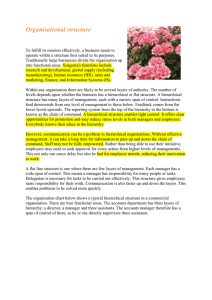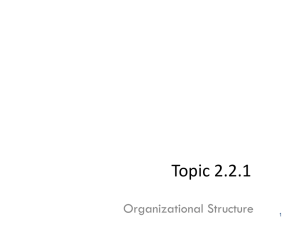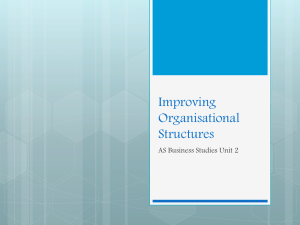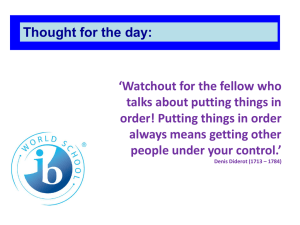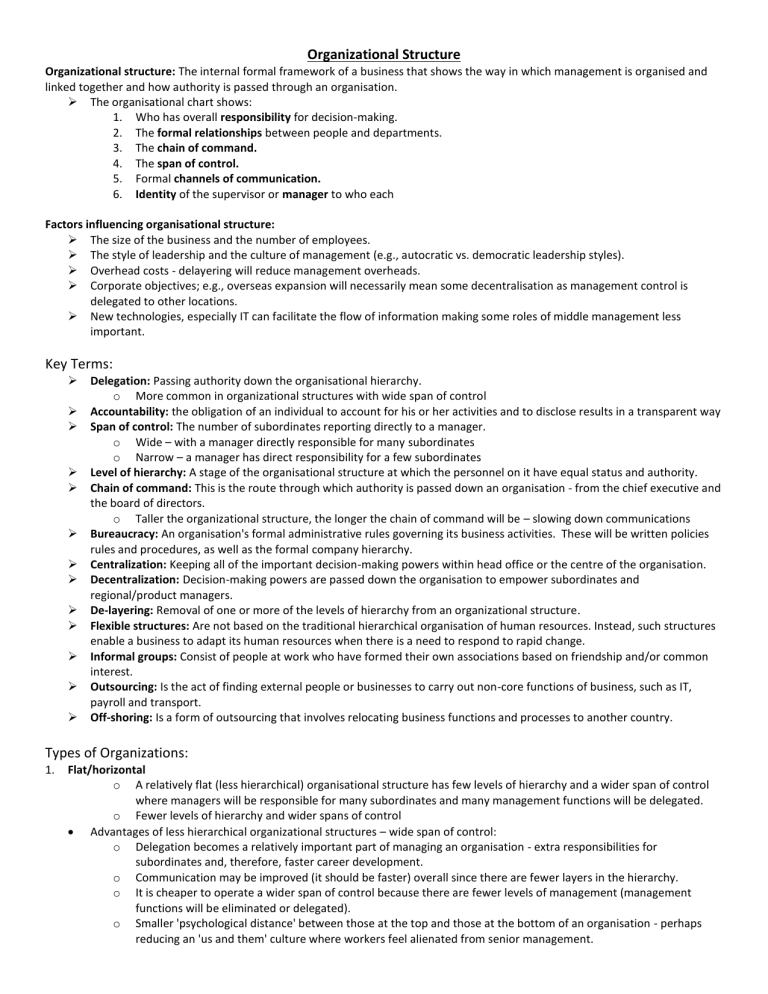
Organizational Structure Organizational structure: The internal formal framework of a business that shows the way in which management is organised and linked together and how authority is passed through an organisation. The organisational chart shows: 1. Who has overall responsibility for decision-making. 2. The formal relationships between people and departments. 3. The chain of command. 4. The span of control. 5. Formal channels of communication. 6. Identity of the supervisor or manager to who each Factors influencing organisational structure: The size of the business and the number of employees. The style of leadership and the culture of management (e.g., autocratic vs. democratic leadership styles). Overhead costs - delayering will reduce management overheads. Corporate objectives; e.g., overseas expansion will necessarily mean some decentralisation as management control is delegated to other locations. New technologies, especially IT can facilitate the flow of information making some roles of middle management less important. Key Terms: Delegation: Passing authority down the organisational hierarchy. o More common in organizational structures with wide span of control Accountability: the obligation of an individual to account for his or her activities and to disclose results in a transparent way Span of control: The number of subordinates reporting directly to a manager. o Wide – with a manager directly responsible for many subordinates o Narrow – a manager has direct responsibility for a few subordinates Level of hierarchy: A stage of the organisational structure at which the personnel on it have equal status and authority. Chain of command: This is the route through which authority is passed down an organisation - from the chief executive and the board of directors. o Taller the organizational structure, the longer the chain of command will be – slowing down communications Bureaucracy: An organisation's formal administrative rules governing its business activities. These will be written policies rules and procedures, as well as the formal company hierarchy. Centralization: Keeping all of the important decision-making powers within head office or the centre of the organisation. Decentralization: Decision-making powers are passed down the organisation to empower subordinates and regional/product managers. De-layering: Removal of one or more of the levels of hierarchy from an organizational structure. Flexible structures: Are not based on the traditional hierarchical organisation of human resources. Instead, such structures enable a business to adapt its human resources when there is a need to respond to rapid change. Informal groups: Consist of people at work who have formed their own associations based on friendship and/or common interest. Outsourcing: Is the act of finding external people or businesses to carry out non-core functions of business, such as IT, payroll and transport. Off-shoring: Is a form of outsourcing that involves relocating business functions and processes to another country. Types of Organizations: 1. Flat/horizontal o A relatively flat (less hierarchical) organisational structure has few levels of hierarchy and a wider span of control where managers will be responsible for many subordinates and many management functions will be delegated. o Fewer levels of hierarchy and wider spans of control Advantages of less hierarchical organizational structures – wide span of control: o Delegation becomes a relatively important part of managing an organisation - extra responsibilities for subordinates and, therefore, faster career development. o Communication may be improved (it should be faster) overall since there are fewer layers in the hierarchy. o It is cheaper to operate a wider span of control because there are fewer levels of management (management functions will be eliminated or delegated). o Smaller 'psychological distance' between those at the top and those at the bottom of an organisation - perhaps reducing an 'us and them' culture where workers feel alienated from senior management. 2. Tall/vertical Tall structure with a narrow span of control (a maximum of two staff directly subordinate) Problems with tall structures: o Communication though the organization can become slow with messages becoming distorted or ‘filtered’ in some way. Spans of control are likely to be narrow – see below. There is likely to be a greater sense of remoteness, among those on lower levels, from the decision-making power at the top. Hierarchical (or Bureaucratic structure) This is one where there are different layers of the organization with fewer and fewer people on each higher level – shape of a pyramid. Most frequently used by organizations where a ‘role culture’, where the importance of the role determines the position in the hierarchy. o o 3. 4. 5. 6. Advantages The rungs on the career ladder for an ambitious employee are illustrated by the different levels of hierarchy. Role of each individual will be clear and well defined, and there is a clearly identifiable chain of command. Disadvantages Tends to suggest that one-way (top downwards) communication is the norm – this is rarely the most efficient form. There are few horizontal links b/w the departments or the separate divisions and this can lead to lack of co-ordination b/w them. Managers are often accused of tunnel vision because they are not encouraged to look at problems in any way other than through the eyes of their own department. This type of structure is very inflexible and often leads to change resistance b/c managers tend to be defending both their own position in the hierarchy and the importance of their own department. Organization by Function: This is the most common organizational structure as businesses have different functional roles such as Finance, Production, Marketing and Human Resources. Organization by Product: A large business that requires a formal organizational structure is likely to be large enough to offer a range of products and it may make sense to structure the organization in terms of product. For example, there may be specific human resource and marketing issues and special requirements associated with the different products that Yum! Brands runs (KFC, Taco Bell and Pizza Hut). This is especially true of conglomerate corporations. Organization by Region: Many multinationals will organize themselves by geographic regions that they operate in. It will make sense to have different human resources, operations and marketing for its Chinese division and separate departments for Latin America, say. Many large organizations will have an organizational structure that is a combination of all three (function, product and region). As can be seen in the organizational structure (above right), this company operates a mixed functional and regional structure. Project-based Matrix structure: An organisational structure that creates project teams that cut across traditional functional departments. With the matrix structure, there is far less control from the 'top' as teams may be empowered to undertake and complete a project. How a matrix structure functions: This method is task- or project-orientated. Instead of highlighting the role or status of individuals it gathers a team of specialists with the object of completing a task or project successfully. Emphasis is placed on an individual's ability to contribute to the team rather than their position in the hierarchy

